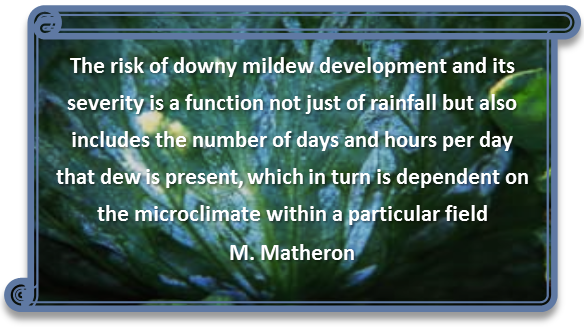
|
|
|
|

|
|||
|
|
|||
|
|
|||
|
Recorded rainfall during December, 2014 ranged from 0.28 to 0.38 inches at the four
Yuma County AZMET weather stations (Yuma Valley, Yuma South, Yuma North Gila, and
Roll). Since downy mildew development depends on the presence of free moisture on
plant leaves, one may expect, based on rainfall alone, that disease incidence and
severity would be relatively equal in the regions where these AZMET weather stations
are located. However, rainfall is not the only source of free moisture in lettuce
fields. The presence of dew on leaves is also very important. Another look at December
weather data reveals that 100% relative humidity was recorded 1, 6, 8, and 12 days,
respectively, at the Yuma Valley, Yuma North Gila, Roll, and Yuma South AZMET stations.
The risk of downy mildew development and its severity is a function not just of
rainfall but also includes the number of days and hours per day that dew is present,
which in turn is dependent on the microclimate within a particular

To contact Mike Matheron go to: matheron@ag.arizona.edu.
|
|||
| Back | |||
|
For questions or comments on any of the topics please contact Marco Pena at the Yuma Agricultural Center.
|
|||
|
Home |
Cotton | Veggies |
Forages | Grains
| Citrus |
Crop x Crop Insects | Diseases| Weeds | Pesticides | Economics | News | Weather | Research | Photos | Contacts | General Info. Copyright © 2001 University of Arizona, College of Agriculture and Life Sciences Webmaster: Al Fournier (acis@ag.arizona.edu) |
|||
